In our era of abundant information, a customer-centric content strategy is key to getting traction. Yet many brands rely on generic, self-promotional content that fails to resonate with savvy buyers.
To get noticed and connect, companies must take a customer-centric approach to content.
This means creating content designed specifically to map to the customer journey and provide value at each stage from awareness to consideration to decision.
It requires understanding prospects’ goals and motivations. And it means obsessing over creating helpful, personalized content that moves audiences along their unique journeys.
In this article, we present guidelines for developing a customer-centric content strategy that aligns to buyer needs. You’ll learn how to:
- Map content to different stages of the customer journey
- Leverage search intent to attract qualified prospects
- Produce a scalable mix of content types and formats
- Distribute content through effective channels
- Measure content performance to refine and improve
With the right customer-centric content strategy, you can produce sticky content that informs, educates and persuades audiences to view your brand as a trusted partner.
Let’s get started.
In This Article
- What is a Customer-Centric Content Strategy?
- Benefits of Using a Customer-Centric Content Strategy
- How to Create a Customer-Centric Content Strategy
- 1. Understand the Sales Funnel
- 2. Figure Out “Jobs to be Done”
- 3. Solve Prospects’ Problems or Deliver Opportunities
- 4. Do Smart Keyword Research
- 5. Meet Search Intent
- 6. Choose Effective Content Types
- 7. Create High-Quality Content
- 8. Optimize for Search Engines
- 9. Include Calls-to-Action (CTAs)
- 10. Understand Channels
- 11. Publish Testimonials & Reviews
- 12. Personalize Communications
- 13. Measure Results
What is a Customer-Centric Content Strategy?
A customer-centric content strategy uses content to solve prospects’ problems or to provide them with desired opportunities.
Not everyone’s ready to buy. And creating content for prospects with different mindsets is vital.
- If someone’s finding out about your business for the 1st time, “Buy now!” messages may not be appreciated.
- Using content to help prospects compare your brand to other options is effective.
- “How to” content can show users that your solution(s) can solve their problems.
Where you publish your content can also impact your results. Different channels serve different purposes.
As you’ll learn, matching your content to a suitable channel makes all the difference.
A marketing channel is a type of marketing. Examples of channels are SEO, email marketing, and social media.
Benefits of Using a Customer-Centric Content Strategy
Customer-centric content, done well, drives sales, revenue, and consistent growth.
Many online businesses rely primarily or exclusively on content to generate business results. Doing so is typically more cost-effective than relying on advertising.
In fact, this is the approach we take in our own business.
Now, let’s look at the elements of a successful customer-centric content strategy.
How to Create a Customer-Centric Content Strategy
These 13 guidelines will help you plan, execute, and measure your strategy.
1. Understand the Sales Funnel
The sales funnel is a helpful visualization for understanding your prospects’ buying journey.
- Awareness: Finding out about your brand for the first time
- Consideration: Exploring what you offer
- Action (Conversion): Ready to buy
As you might guess, these 3 prospect groups have different information needs and wants.
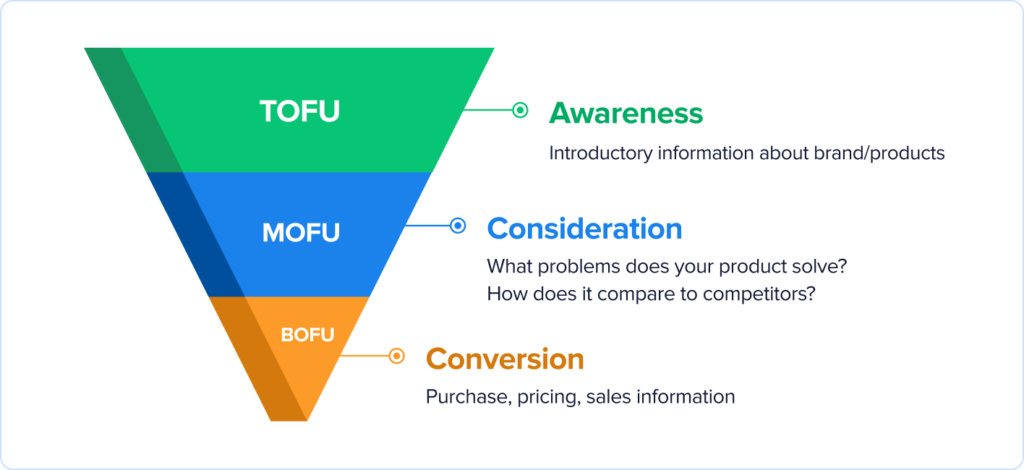
Keeping these stages in mind will help you create compelling, customer-centric content.
2. Figure Out “Jobs to be Done”
Next, by understanding your prospects’ “jobs to be done,” you can attract and convert qualified leads.
The “Jobs-to-be-Done” approach is simple: Focus on your prospects’ goals. What do they want to accomplish?
Finding the overlap between your prospects’ goals and what your solution offers is the seedbed for compelling customer-centric content.
The Jobs-to-be-Done framework was created by Tony Ulwick, founder of the consulting firm Strategyn. Innovation expert Clayton Christensen popularized the framework.
Christensen explained in Harvard Business Review:
When we buy a product, we essentially ‘hire’ it to help us do a job. If it does the job well, we hire it again. If it does a crummy job, we ‘fire’ it and look for something else to solve the problem.
While the Jobs-to-be-Done framework was initially applied to product innovation, it can just as easily be applied to content.
How to use this: Before creating content on a particular topic, ask: “What ‘job(s)’ does our target audience need to get done? What elements of the process are important to them? How do they measure success?” Let your answers shape your content.
Example: If your article is on “How to fix a small drywall hole,” your audience will need to know the required tools and materials. Listing these early in the article can help your reader get organized and do the task efficiently.
Summary: Content focused on “jobs to be done” will raise brand awareness, attract prospects, and show how a product or service can help them accomplish their goal.
3. Solve Prospects’ Problems or Deliver Opportunities
This step is closely related to jobs-to-be done.
Jot down common problems your prospects have or opportunities they want.
Examples are:
- Find a good leaf blower at a budget price
- Sign up for a local “learn to knit” class
- Write a resume that makes it past automated tracking systems
- Improve the ranking of your recipe website
Creating this list will help you choose topics to cover.
Imagine yourself in your prospects’ position so you can focus on what’s most important to them.
How to use this: For instance, if you own a plumbing business in a region with freezing winter temperatures, prospects are likely concerned about (1) avoiding frozen pipes or (2) getting a 24-hour plumber to fix frozen pipes.
- Content that helps them avoid frozen pipes will earn goodwill while raising awareness of your business.
- A web page with a prominent number to call for 24-hour service will earn revenue.
You can also get ideas by doing a Google search on your list of problems. Look for a feature called People Also Ask questions in search results: these are the most common questions people have on the topic.
In your content, answer some People Also Ask questions. Remember: these are questions most people already have on the topic.
Summary: Creating SEO-optimized content to solve prospects’ problems or deliver opportunities will attract a qualified audience.
4. Do Smart Keyword Research
Keyword research can seem daunting, but it’s easy once you grasp it.
Base content on a keyword: Think of a keyword as the main topic of your page. And think of Google as a librarian.
Imagine you donate a history book to your local library. The title and blurb make the book’s topic clear. The librarian knows precisely how to classify the book and where to place it in the library. As a result, visitors can easily find it.
Similarly, your keyword helps Google understand where your content fits with the overall web and which search queries it might be relevant for.
Use keywords well: We recommend using the All in One SEO plugin to optimize your keyword use.
The plugin will check to see if your keyword’s present in your:
- Title
- Page description (also called a meta description)
- URL
- First paragraph
- Several subheadings
- (Optionally) in some image descriptions (called image alt text)
This helps keep your article focused on the main topic, which benefits readers and Google.
Pick easy keywords: If you want to rank high for its keyword, pick keywords that are easy to rank for. Learn how to do this in our guide on Keyword Difficulty.
Unseat competitors: Did you know you can find out which keywords your competitors are ranking for and you aren’t? Then, you can analyze their article and create a better one, siphoning off their prospects. Follow our instructions in Keyword Gap Analysis.
5. Meet Search Intent
Once you choose a keyword (topic) to create your article on, take a few minutes to discover the search intent behind the keyword.
Search intent is the mindset and motivation of searchers revealed by search engines.There are 2 complementary ways to find search intent.
Use Chrome Incognito to do a keyword search.
The 1st method is to use Chrome Incognito to search for your topic. Follow these instructions and jot down insights to help you create an article valued by your prospects (and Google).
You’ll pick some People Also Ask questions to answer in your article. And check to see if all the top-ranking articles have something obvious in common.
For instance, are most articles on page #1 of search results step-by-step tutorials? Or listsicles? That may tell you what people expect from an article on that topic.
But if all the top-ranking articles for your keyword are low-quality (a sign of lack of competition), you may want to ignore the format of the top-ranking articles.
Use your judgment and be willing to experiment.
Use a keyword research tool to discover “keyword intent.”
Keyword Research tools like Semrush categorize keywords according to 4 intents.
Intent | Semrush symbol | Description | Example |
|---|---|---|---|
| Informational | I | The user wants to find information and doesn’t signal buying intent. | “who is the CEO of Apple” |
| Navigational | N | The user wants to navigate to a specific website or page. | “Home Depot credit card login” |
| Commercial | C | The user has clear buying intent and wants to compare products or read reviews. Or they are trying to solve a problem and are open to buying a solution. | “WPForms vs Gravity Forms” “Best budget leaf blowers” “How to add schema markup to WordPress pages” |
| Transactional | T | The user is on the brink of buying and responsive to sales, discounts, transaction details. | “Book cruise from Tampa” “Car insurance quotes no deposit Florida” |
One of the benefits of knowing how your keyword is labeled is it will shape how you cover the topic. Also, you can target keywords that signal buying intent.
Summary: If you want to rank well and convert qualified prospects, make sure your content is designed to satisfy the search intent behind your chosen keyword.
6. Choose Effective Content Types
Creating effective content starts with keeping the sales funnel in mind.
Awareness: Newsfeed-based social media platforms, like Facebook, can be good places to grow brand awareness. Remember that people are there to socialize, so light content often works best.
Think content “snacks” – charming anecdotes, appealing photos, short videos, or interesting statistics. And don’t overlook the power of Facebook Ads.
Learn more in SEO vs. Social Media: How do their roles differ in digital marketing?
For articles, focus on providing introductory information or define relevant terms in simple ways.
This example below from Masterclass.com answers the question: “What is Bebop?” The article is short and easy to understand. Site visitors will learn that they can sign up to take video classes from jazz greats.

Consideration: Prospects with this mindset have buying intent, but need more information. Use “how-to” articles to help them solve problems with your solution. And create content that helps them compare your solution with your competitors. Learn more in our article 7 SEO Secrets the Pros Use to Grow Revenue.
Decision: Content-wise, there’s a lot of overlap between Consideration and Decision. If you help prospects compare your solution to competitors and see how it solves problems, they may become convinced your solution is best and decide to buy.
Don’t neglect to sell via email marketing. Those on the brink of buying respond well to discount offers and sales.
7. Create High-Quality Content
After you’ve planned your content, you may be wondering how well it will rank in Google search results.
Two of the most significant predictors are:
- How easy your keyword is to rank for
- The quality of your content
In fact, quality is the #1 ranking factor. By “quality,” we mean how helpful the content is to the user and how well it meets search intent.
Here are some tips for creating valuable content.
- Be competitive: How will you best the top-ranking content?
- Create an outline first. That will help keep your article focused.
- Write in “plain English.” And follow Orwell’s 6 Rules for Writing.
- Format for skimming. Learn How to Create Scannable Content.
8. Optimize for Search Engines
After creating your content, optimize it for search engines.
WordPress site owners can use an SEO plugin to do this. We recommend All in One SEO (AIOSEO), a beginner-friendly plugin known for delivering powerful results.
All in One SEO is an established plugin with thousands of 5-star reviews on WordPress.org. Currently, over 3 million people are using it.

AIOSEO will analyze your page and guide you, step-by-step, toward better SEO.
After you download and install All in One SEO, navigate to a page you want to optimize. The plugin’s recommendations are in a sidebar right inside the WordPress editor.

Once you become familiar with the process, it will only take 15 minutes or less to optimize a page.
You can also improve your online visibility by taking advantage of the following AIOSEO features.
- SEO Analysis: This tool shows you how to improve your homepage SEO. Ensure you’re ranking high for your website or business name.
- Link Assistant: Automatically find internal linking opportunities to boost ranking and increase time spent on your site.
- Local SEO: Fill out a form and AIOSEO makes sure search engines have your business details so they can appear in local search results and Google Maps.
- Rich Snippets Schema: Instantly add special code so product reviews, multiple images, discounts, and shipping information are eligible to be displayed in search results.
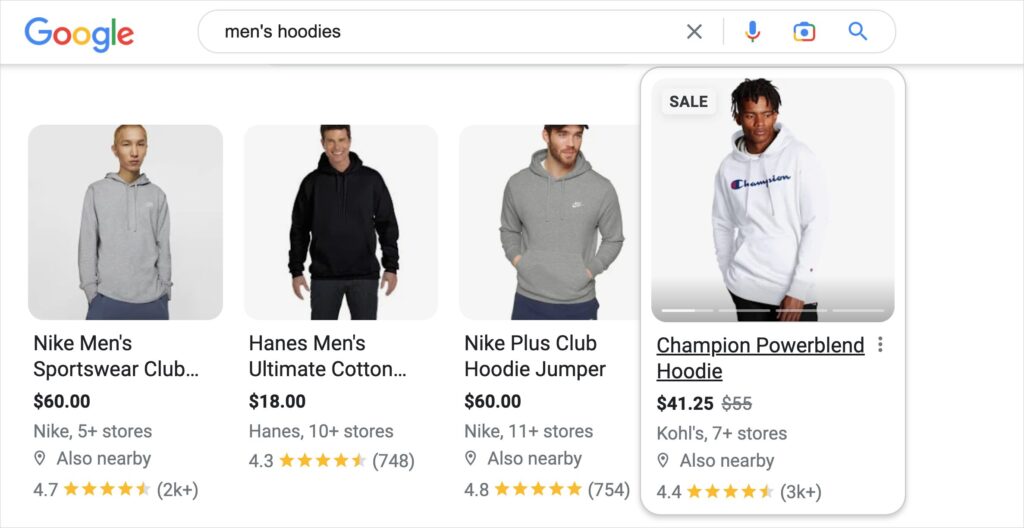
Above: These rich snippets feature product ratings, prices, discounts, and more.
9. Include Calls-to-Action (CTAs)
Once you’ve optimized your content, be sure to include at least 1 call-to-action (CTA) on the page.
Ask yourself: “What do you want visitors to do when they arrive on your page?”
Depending on your goals, the answer might include:
- Subscribe to an email newsletter
- Register for a webinar or in-person event
- Request a demo
- Enter a contest
- Watch a video
- Purchase something
- Sign a petition
- Sign up to download a free e-book
- Leave a comment on an article
- Subscribe to your YouTube channel
To maximize results, place your CTA near the top of the page. Many web visitors don’t scroll down.
Ideas: Browse these lead magnet ideas. Use OptinMonster to create powerful exit-intent popups. (These appear when people are getting ready to leave your site.) And explore Beacon.by: a tool for creating professional-quality lead magnets.
10. Understand Channels
Next, matching your content to the right channel is key.
Remember, you’ll be creating content to match 3 prospect stages: Awareness, Consideration, or Action.
The good news is there are channels that work great for reaching prospects in each of the stages.
SEO is one of the few marketing channels effective for reaching your prospect at any stage.
Use the chart below to pick the right channel for your Awareness, Consideration, or Action content.
And learn more in How to Drive Revenue the Smart Way.
| Funnel stage | Awareness (See) | Consideration (Think) | Decision (Do) |
|---|---|---|---|
| Marketer slang | TOFU | MOFU | BOFU |
| Keyword intent | Informational | Commercial | Transactional |
| Effective channels to use | * SEO * Newsfeed-based social media * Facebook Ads * Display Ads | * SEO * YouTube * Display Ads * Retargeting Ads * PPC Ads | * SEO * Display Ads * Retargeting Ads * PPC Ads * Local Services Ads |
| Content types | * Content snacks * “What is” (definitions) * Introductory content * General how-tos | * Product comparisons * Product reviews * Comparison tables * How-tos * Testimonials | * Product comparisons * Product reviews * How-tos * Purchasing details * Sales/discount info |
11. Publish Testimonials and Reviews
Testimonials and reviews are the digital equivalent of word-of-mouth marketing.
This content can persuade prospects to consider what you offer or to buy.
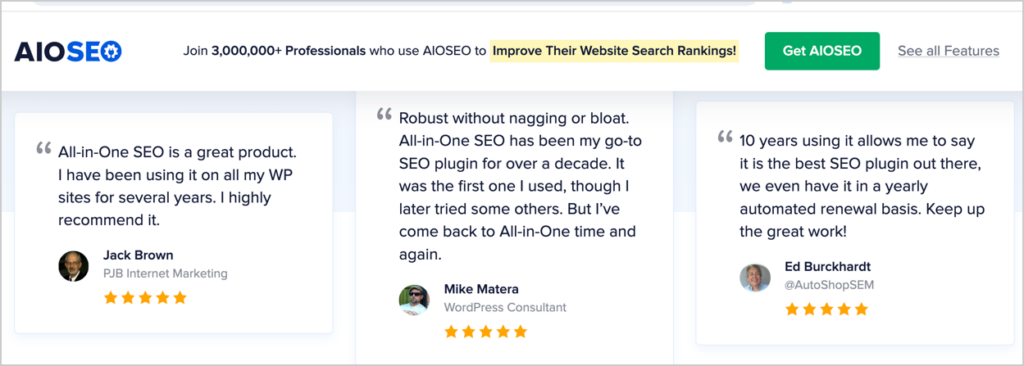
Above: Customer testimonials on the AIOSEO.com homepage.
How to use this: Add testimonials and reviews to your site and include them in email marketing.
- You can embed Google Reviews on your WordPress website by using the SmashBalloon plugin.
- Deliver instant social proof with the low-cost TrustPulse plugin.
If you have a local business, regularly ask for Google Reviews. These reviews can impact your local ranking.
Learn more in How to Manage Google Reviews for Improved SEO.
12. Personalize Communications
Dale Carnegie famously said that “A person’s name is to that person, the sweetest, most important sound in any language.”
Thanks to the marvels of modern software, you can automatically personalize all sorts of digital communications with your prospects and customers.
The main way this is achieved is by sign-ups.
When someone signs up for a webinar or email newsletter, you’ll have their email address, and, if they choose to fill out their name, their name too.
Subsequent emails can automatically address them by their first name. This functionality is included in most email service providers such as Drip and ConvertKit.
Behavior-based marketing: In addition, behavior-based marketing software, like Ortto, can, at the point of conversion, append a user’s previously anonymous site behavior to their record. You can see which pages they visited before and after they downloaded or signed up for something.
More importantly, you can program messages to be displayed or sent in response to the user’s behavior. And these messages can occur across several platforms, including your website, email, SMS (text messaging), on-demand print postcards, and more.
All of the messages can greet visitors by their first name and make content or product recommendations based on the user’s browsing and purchasing behavior.
This is a powerful form of marketing because it’s customized to each user. And because it’s automated it’s a big time-saver.
Platforms like Ortto can also enable site visitors to designate how they prefer to receive communications, e.g., by email, text message, or push notification.
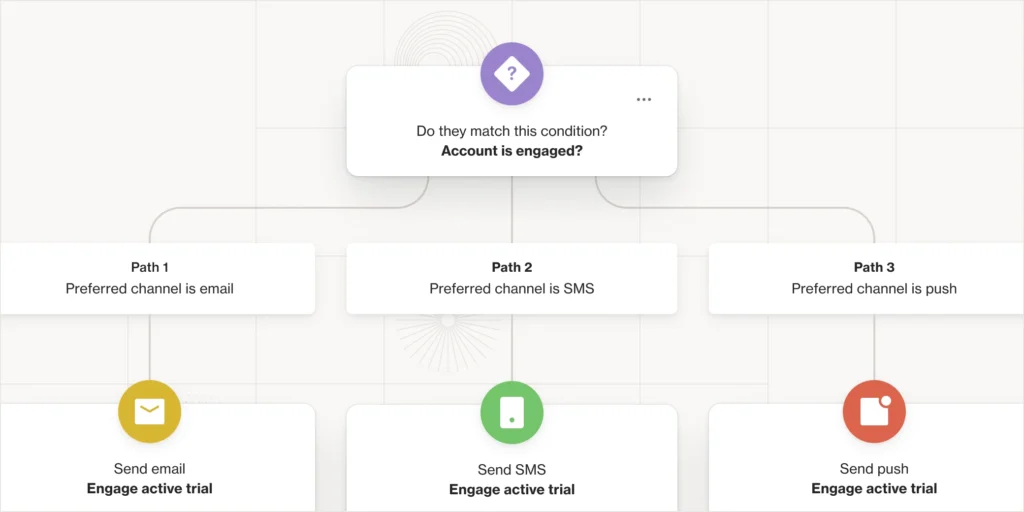
In addition, standalone recommendation engines also fall into the personalization category. These are software programs that make content or product recommendations to visitors based on what’s popular or their previous browsing behavior.
Learn more in Product Recommendation Strategies.
13. Measure Results
Lastly you’ll want to measure the results of your customer-centric content strategy.
First, you’ll want to know how you’re ranking in Google. Which keywords are you ranking for?
Here, All in One SEO can guide you. The Search Statistics feature will show you how you’re ranking and you can find out without leaving the WordPress editor.
In addition, you’ll find out which keywords your rankings have improved for, and which ones your content is slipping in.
This helps you prioritize content improvement.
The Search Statistics feature is available in the Elite version of All in One SEO (AIOSEO)
Q&A on Customer-Centric Content Strategies
What frameworks can be used to create a customer-centric content strategy?
We’re big fans of Avinash Kaushik’s marketing frameworks, all of which are customer-centric. These frameworks include the See – Think – Do – Care framework, the Acquisition – Behavior – Outcomes model, and the Digital Measurement and Marketing Model.
Kaushik is a world-renowned marketer and a long-time analytics leader at Google. He recently joined Croud as their Global Chief Strategy Officer.
What is a customer-centric social media strategy?
A customer-centric social media strategy needs to take into account the strengths and weaknesses of various social platforms and then matches the right content to those channels.
Consider using the See – Think – Do framework to ensure your social efforts are effective. Learn more in SEO vs. Social Media.
After Creating Your Customer-Centric Content Strategy
Now that you have guidelines for creating and effective customer-centric content strategy, what’s next?
Learn how to use topic clusters to accelerate SEO results. Explore how to combine email marketing and SEO to boost revenue. And achieve strategic advantage with content gap analyses.
Come join us on our YouTube Channel to find simple WordPress SEO tutorials. You can also follow us on X (Twitter), LinkedIn, or Facebook to stay in the loop.
Disclosure: Our content is reader-supported. This means if you click on some of our links, then we may earn a commission. We only recommend products that we believe will add value to our readers.
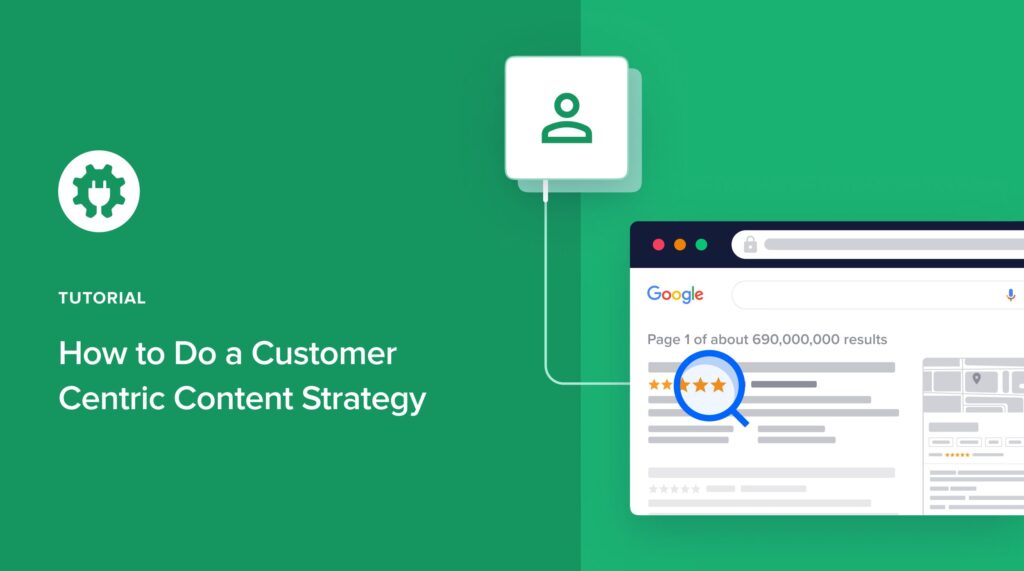

Great article. It was a real pleasure to read. You’re doing great.
Crafting a customer-centric content strategy is pivotal in driving conversions. This insightful guide offers actionable tips on aligning content with customer needs and desires, ultimately leading to more meaningful engagement and higher conversions. A must-read for marketers aiming to enhance their content strategy’s effectiveness